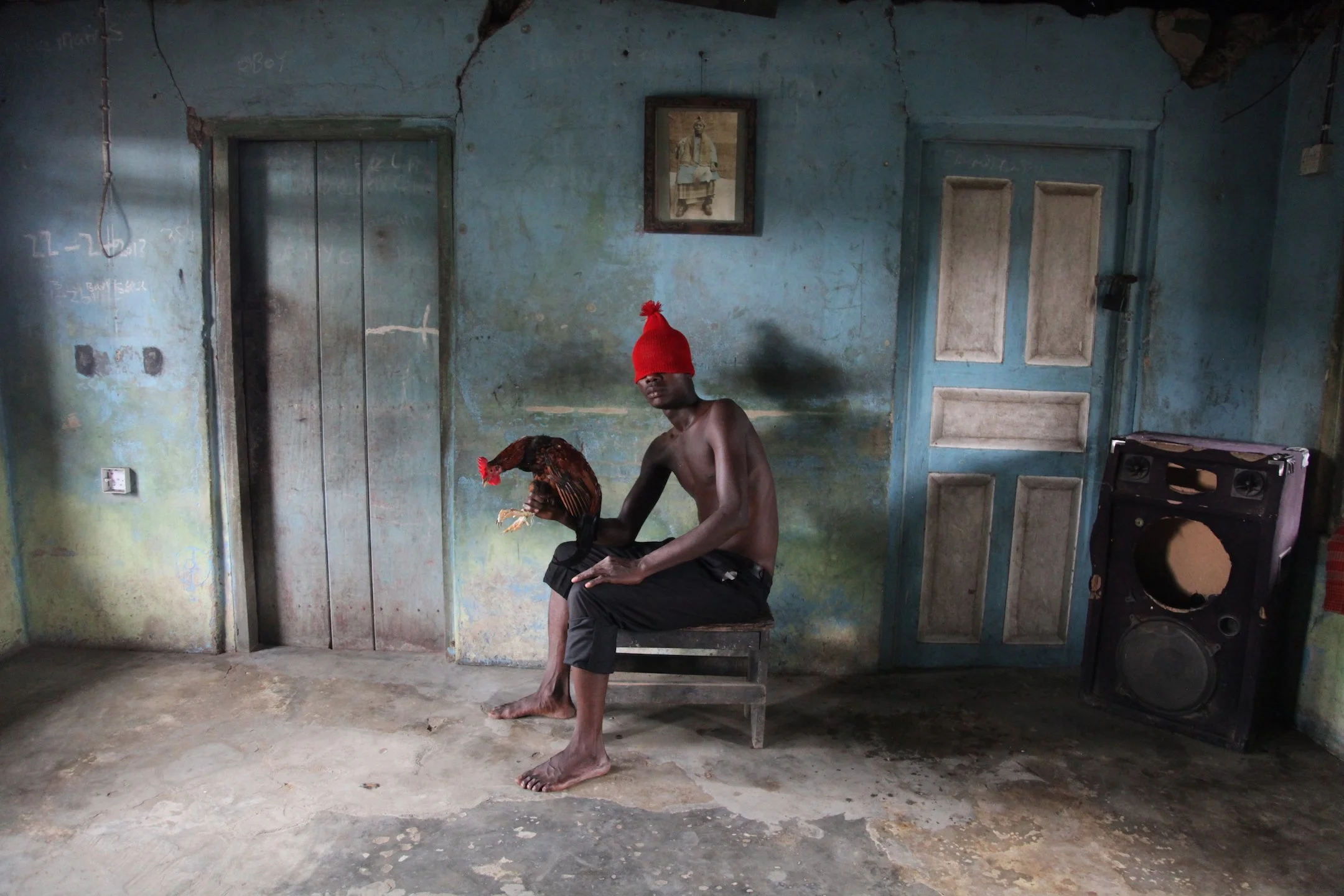INVISIBLE BOY
The Invisible Boy series emerged from previous body of work created by Zina Saro-Wiwa in 2014 titled Men of the Ogele. Men of the Ogele is a documentation of an illusive modern Ogele masquerade sect discovered on her return to her ancestral Ogoniland.
Saro-Wiwa’s statement on the Invisible Boy series:
“I first saw him when I was photographing an Ogele masquerade troupe in Ogoniland. A dark, gangly man-boy who purposely wore his red cap over his eyes. He had a very strange body and he moved differently to everybody else. He enjoyed posing but remained mysterious at all times. Eyes always covered. I found myself very drawn to him and his incredible physicality and I used him in quite a few of the photos. This was back in 2014. Five years later, I felt called to return to him as a solo subject. The body of work that emerged was different from the ‘Men of the Ogele’ series. There were no costumes to document for start. Just a bare torso with a red cap. The entire series is less prescribed and less anthropological. The invisible boy was using my camera to tell the stories it wanted.
The Invisible Boy series heralds my immersion into the subcutaneous layer of life in Ogoniland. A place that is deeper than culture. I am not talking about the spiritual life that manifests on the surface as animist religion. This spirituality does not have a name and does not have deities. It has a deeper more elemental voice. And once I tuned in to this frequency that is when my art practice shifted. I began to let go of the more anthropological significations of Ogoni identity and got in touch with this spirit and let it lead me where it needed me to go. This Invisible Boy figure represents, therefore, a pivotal moment in my practise, representing the move away from the surface to the subcutaneous. It allows me to tap into a universality and a potent and generative mystery. It makes the Ogoni narrative a global if not cosmic one. We are dealing directly with the land on its own terms. This shift ties in with my interest in object oriented ontologies and actually the ways in which African ontologies have, for centuries, prioritized multiple perspectives of life on earth before this fashionable thesis. We have never seen the world through simply human eyes. We always known and valued the perspectives of plants and trees and animals and soil. We always listened. And this is the environmentalism that I want to foreground and build on. This is a decolonial environmentalism that I have felt is vital for us to move through this period of oil devastation. Anti-oil activism that is Western in origin is not enough to bring the change we require.
“These Invisible Boy photographic works are still revealing their meanings to me. It was a very aesthetic exercise. There was nothing anthropological guiding me here. Because this was about the man behind the mask. The spirit behind the proceedings. A new, acultural prospect. This photographic series is the beginning of an investigation into this invisible realm that informs so much of Ogoni life. I was very much led by aesthetic choices in this series. I didn’t know why I was choosing to go where I was going but I just did it because it felt right and had a visual potency. It was only afterwards that I started to discover the significance of the things I was drawn to. The symbolism of the chicken that I decided to incorporate for no apparent reason. The power and history of the extraordinary tree I photographed him in. This submission to aesthetics has led to a greater understanding of Ogoniland and the spiritual realm. The information is actually within the beauty and beauty actually has significance and meaning embedded in it.
“Finally I want to talk about secrecy and the forest which are important themes in this series. This Invisible Boy figure is, for me, the product of the union between man and tree. When masquerade players are creating their themes and songs and mask ideas, they disappear to the forest for months to create the songs and dances and themes of the masquerade. Nobody knows much what they get up to. Many suspect it’s just a boys club to get away from their families. But whatever the case may be, the location to me is vital. I’ve begun to entertain an idea about the ways in which trees might communicate with or speak through us. That they might eavesdrop on us and suggest things back to us. I feel like masquerade is the symbolic bridge between trees and humans. The product of the shadows. The invisible boy for me, is proto masquerade. The love child of human intention and tree spirit/s. An embodiment of the entity that shapes and animates masquerade. But one that will not speak it’s own name. The cultural performance of secrecy is very important in Africa and this invisible boy is this idea made manifest. As they say: a secret is a sign of itself.”





